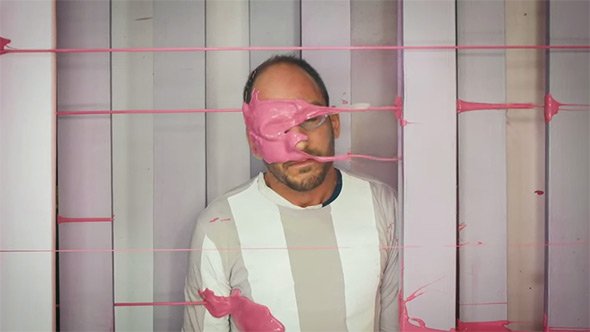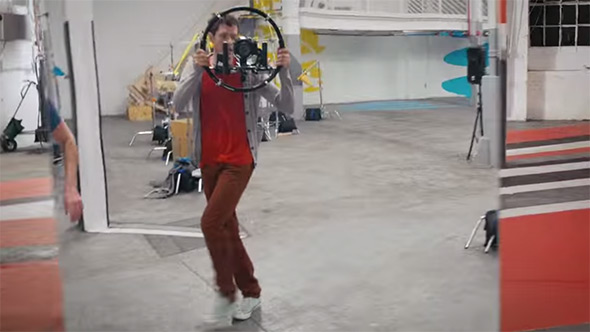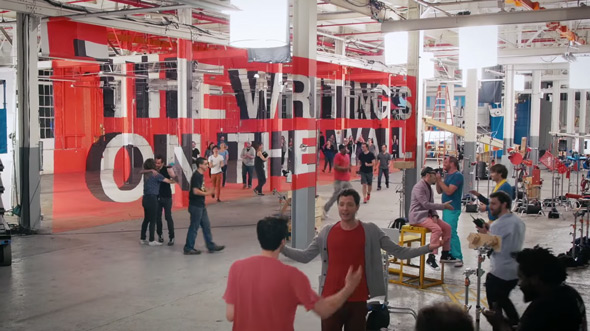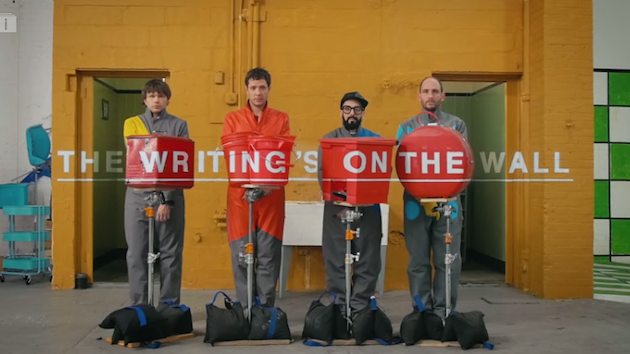Breaking 'the Fifth Wall' and Getting All the Illusions in One Take
The latest inventively staged music video from procedural magicians OK Go has already been watched more than 9.7 million times since premiering last month. "The Writing's On the Wall" has also just earned its directors, Aaron Duffy, Damian Kulash, the band's lead singer, and Bob "ThingamaBob" Partington, the video's architect, a VMA nomination. Duffy is a partner and creative director of 1stAveMachine and founder of experimental creative agency SpecialGuest. He has directed high-profile spots for Google and Audi, including the Cannes Lion-winning Audi Unboxed.
So how did Duffy, Partington, Kulash and the indie rock band, known for its single-take Rube Goldberg video productions, make something new? With one long take deceptively above, below, beside and behind the scenes that puts the fun and the craft back into production itself. DP Will Rexer, and the band members, shot with a Panasonic Lumix DMC-GH4 4K Micro Four Thirds camera.
We asked Duffy and Partington what it took to make a shoot like this happen. You can watch the real behind-the-scenes video here.
StudioDaily: How did the idea for the video—one uninterrupted take that breaks the fifth wall and plays with our notions of perception—develop?
Aaron Duffy: The single-take concept is a hallmark of the OK Go music video. But it’s not just a branding thing. Damian and the band clearly like to work for their audience. They want the video to be an achievement. That was very clear to us as directors early on—pretty much directly after our first call with Damian, Tim and Mary. Since Bob and I had already done several one-take contraption projects together, we knew what we were up against. Every idea that came to the table was understood as a puzzle piece that had to be seamlessly integrated. At first, that realization caused us to rule some ideas out. But over time and as we gained confidence in the probability of production, many of the risky ideas were, fortunately, snuck back in. The idea of breaking the fifth wall came up as a solution to a problem we were having conceptually. We loved the illusions, but there was something about them that didn’t fit at first. Some of the best illusions just worked better without human intervention. But that went against the tight integration we wanted from the band. In the end, we reminded ourselves that the core excitement of most of the illusions came from the position of the camera, and if we wanted to truly make the band responsible for these illusions, they would have to do more than just stand inside them—they would need to be part of the camera operation. That decision tied the film together and it really made sense. After all, it’s pretty standard for music videos to break the fourth wall. It’s typical for the singer to say the words right into the camera like they are speaking to the viewer. But it’s not so typical to task them with operating the camera, especially when it’s a one-take illusionistic marathon obstacle course.
Bob Partington: The idea that Damian and the band came up with was a music video where the band would be making these illusions, like the ones of artist Felice Varini. We spent several weeks just concepting, and what came out of that was not only a whole lot of awesome ideas like we put into the video but also the reality that these kinds of illusions are things that already exist as static compositions, so the video adaptation of the concept is not so much about building the illusions as much as it is having a viewer see these things build and break. It became clear to us that the only place where we could make the band essential to completing the choreography and the video was if the band was actually showing each illusion to the viewer, breaking the fifth wall. This meant that they had to actually grab the camera and move it around and turn it into place for each illusion.
SD: All that camera passing likely required some tricky staging and choreography. How long were you in pre-production and rehearsal before you did a first take?
AD: We broke down the time we had as best we could. In total, the production was two months: one month for concepting and one month for building. Our D.P., Will Rexer, and his team had one day to light and then we had one day to shoot and rehearse. We had originally planned on a week of rehearsal and two days of shooting, but I think we all knew from the very beginning it was going to be down to the wire. We came very close to not getting it. The reasons we did get it: an incredible art department run by Ethan Tobman, engineering genius, for the rigs and co-direction; Bob and Ciera for wardrobe; a “can-do anything” attitude from Rexer and his team; a very patient and supportive producer team in Cheri Anderson and Garrett Fennelly; an amazing bunch of volunteers who painted through the night; and finally, a band who I am pretty certain can do absolutely anything (or die trying).
BP: OK Go videos tend to have the look of a work-in-progress. This was definitely the case with this one. We had a month of concepting and a month in the space—we went in there with a whole lot of ideas, and it became all about placing them and finding the most interesting ways to move between them, thinking about the arc of the song and practical challenges of the location. I'm not even sure exactly when rehearsals started. I recall that we were just working and working and working. At some point during the eleventh hour we were really starting to wonder if we were going to be able to pull this off—and all of a sudden, wow, we just got a full run-through! This was halfway through the second day of our two-day shoot.

SD: How many takes until you got it just right? And how were you both monitoring it, or involved on set, throughout?
AD: This is a subject that puts a pit in my stomach: We did 61 takes, but only a scant few of them were usable. Most of those takes only got us through the first couple of illusions before we had to restart. The main problem was there were two illusions that had long reset times: Tim’s half beard and Dan’s paint drop. To make that beard look even remotely real, our make-up lead, Dayone, needed about 10 minutes to arrange it and blend it in. And every time we did Dan’s paint drop, the five-person paint team needed about 20 minutes to clean it up and reset it. So if we ever thought that something didn’t look right prior to either of those illusions, we would cut and save ourselves the reset time. The only issue with that is I was the only one who could see if things were going right. We did not have the budget for a VTR or video-village setup. The GH4 was able to send out one temperamental WiFi signal to an iPad, which I clung to as I zipped around behind the camera, trying to stay out of view. So I watched carefully to make sure we were going strong before deciding that we could drop the paint, hoping that I was right. We did that until 3 in the morning before we felt we got it. Upon reviewing all the takes, I would say we had only a handful of complete takes to choose from, and the one that ended up on YouTube was clearly the best one. Even the hero take has some moments that just didn’t work as we’d like them to, but we’re thankful for that one take anyway.
BP: Because of the complexity of the one-shot in-camera, the reset, as Aaron says, was a really big issue with very little time left on the clock. While I was on the camera rigs and Damian was doing his thing, Aaron was on the monitor deciding if the take was worth carrying through to completion or if we should call it off before it hurt us too much time-wise. So even with those official 61 takes, not all of which were full run-throughs, it was somewhere around the 30th take that was the magic take— and we like that we got a nice smile out of Damian, too!

SD: As we see from one mirror shot in the video, a Fig Rig was the go-to stabilizer. The behind-the-scenes video reveals all the other rigs, dollies and setups that you, Bob, and the crew built. Which one was the hardest to figure out or pull off?
BP: The rigs were a really fun part of this, and we built them all on the cheap using Home Depot stuff. They all had their respective difficulties—the 20-foot arm that took the camera over Tim’s face was probably the biggest build, with a lot of garage-door springs in that one. But the most difficult thing was the fact that this Fig Rig, shaped like a steering wheel, had to enter into a holder that was secure enough so the camera could go upside down and spin around, and then someone could quickly and easily take it back out again. I designed a system using magnets and springs that would perform these tasks, and built it on site. Once we had the system finally figured out it was pretty reliable—we only dropped the camera once! And, as is the nature with these works-in-progress projects, every rig had to be altered and rebuilt because we kept figuring out things that would make the choreography work better.
AD: I just want to point out that Bob was the one-man engineering team for all the rigs. From my perspective, the “diorama world” was the hardest to pull off. Damian and I spent a night counting out how much time it should take for the camera to get through that section, and Bob built a z-axis rotation dolly with two different rotation speeds to fit that timing. It was certainly the most math-y of the bunch.
For me, the moment in the video that was the most difficult to pull off was not due to rigging issues. It was the series of mirrors that each band member was hiding behind. As viewers can see, Damian is holding the camera rig while he walks across the [screen] and (in theory) each band member was meant to mimic him in between the mirrors, giving the viewer the impression of a single figure changing form. The hard part was that the band had no idea where Damian might be at any given time. Ideally, we would have had little monitors for them behind the mirror walls so they would know—the same kind that puppeteers use. But it just wasn’t that kind of production. I’d say it worked, but with another two days of rehearsal, it would have been tight. That was one of the casualties from my point of view, but I’ll take it.

SD: The shoot required a sizable crew, seen emerging from your deceptive wall at the end. What a cool way to give credit where it's due! What was unique about this production compared with other recent shoots you've done?
BP: Certainly it's awesome to see everyone involved in the production get credit—that is what is unique, exciting and different about this one! And it's not just giving credit where credit is due, but sharing the excitement with the crew, which is a genuine thrill because everyone is invested in this and wants to see it pulled off, and everyone is participating in it physically. That feeling of celebration at the end of the video is something that I really love about OK Go videos, and going into this project I was really hoping that we could pull that off. It was well into production at the location when we started painting the giant mural, and we realized there were all these blank spaces behind columns and objects. It just became perfectly clear. This is where we can hide everybody! We hadn't planned on celebrating at the end—everyone was supposed to just go about their business. What's great is no one could contain their excitement.
AD: We had the most amazing and passionate crew. Everyone had the chance to show everything they can do, and they took it head on. There was nothing comfortable about this production. We had very late nights, working weekends, labor intensive builds, a very leaky warehouse ceiling, monotonous activities, mind-numbing engineering and math, and very little time. Every single person who comes running out from behind those columns at the end was completely essential in their own way and brought value to the production. Every crew member came with patience and great ideas. It’s mind-boggling to think about what would have happened if we did not have any one of those team members.
I have had a lot of time now to think about how this shoot was different than most that we do. Fortunately, Bob and I have been lucky to do a lot of crafty, in-camera productions. It’s what we love to do. But most productions simply can’t be like this one. The key factor is that Bob, Damian and I were co-directors and Damian was also essentially our client. That is as rare a working relationship as they come in what we do, and it creates a completely different dynamic. It presents the most opportunity for great creative because we were able to work directly with our client face-to-face. At the same time, it comes with great risk. We had nearly no checks and balances. We could have very easily arrived on shoot day and realized that what we had conceived was actually impossible. In retrospect, we knew very well that “impossible” was our goal, and we would just have to make it work. Without a doubt, that’s what we live for—and we will be dreaming about the next one.
Crafts: Shooting
Sections: Creativity
Topics: Article aaron duffy bob partington damian kulash dmc-gh4 Fig Rig OK Go music video
Did you enjoy this article? Sign up to receive the StudioDaily Fix eletter containing the latest stories, including news, videos, interviews, reviews and more.










Leave a Reply